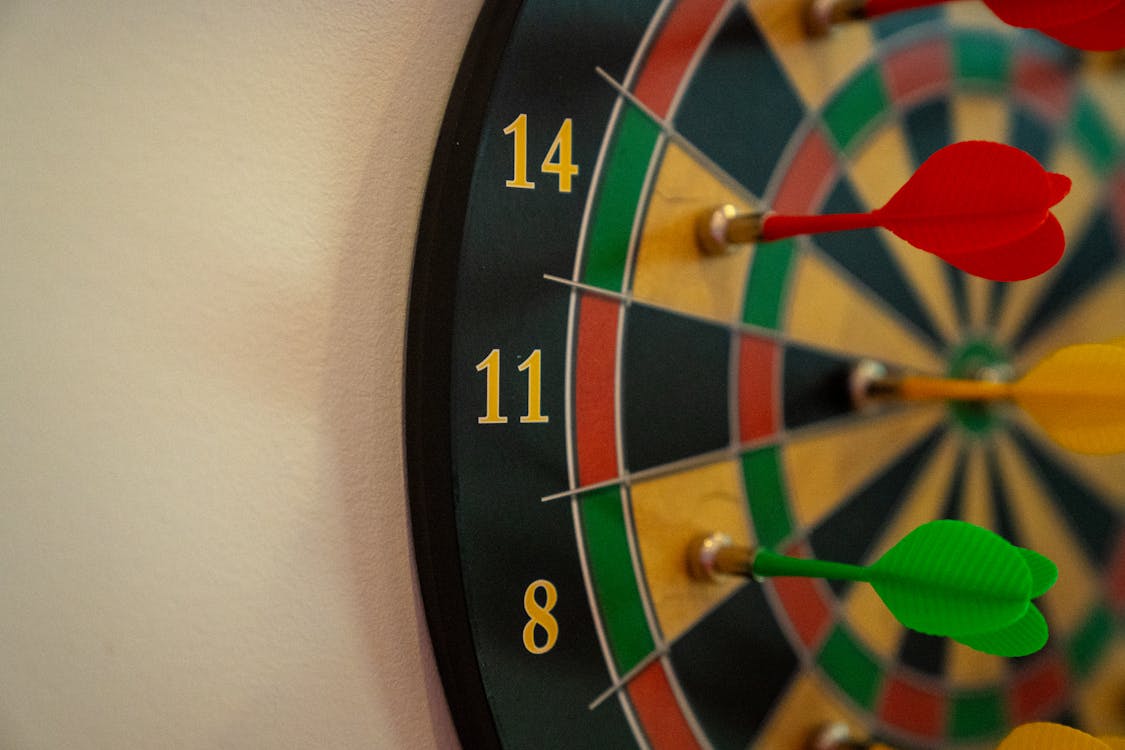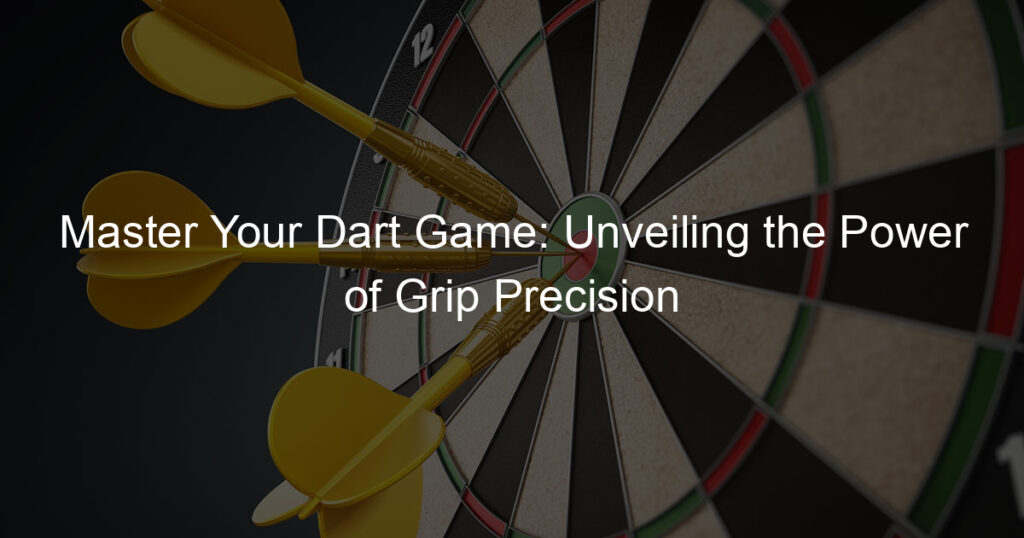Do you want to up your game when it comes to darts? Are you looking for the perfect tactical strategy to get ahead of your competition and take the top score in any tournament?
Whether you’re just starting or you’ve been playing darts for years, it’s important to know the dart distance rules. Understanding the dart distance rules is essential to becoming a competitive player. Read on as we break down all the important details you need to know about dart distance rules!
What is the proper distance for darts?
When it comes to playing darts, getting the proper distance from the dartboard is a key factor in achieving the best results and having the most fun.
The regulation distance for professional dart players is 7 feet 9 ¼ inches from the center of the board, though recreational players generally opt for a shorter distance of around 6 feet 8 inches.
As far as angles go, throwing at 90 degrees (or straight on) with your shoulder is ideal, but slightly angled towards to board also works well – just be sure to keep track of your techniques and measurements so you can better improve over time!
| Distance | Description |
|---|---|
| Throwing Distance | The throwing distance in darts is 7 feet 9.25 inches (2.37 meters) from the face of the dartboard to the toe line or oche. This is measured horizontally, not diagonally. |
| Height | The bullseye should be 5 feet 8 inches (1.73 meters) above the floor. The center of the bullseye should be exactly 5 feet 8 inches (1.73 meters) from the floor. |
| Scoring Area | The scoring area on a standard dartboard is divided into 20 numbered sections, each worth between 1 and 20 points, with the outer and inner bullseyes worth 25 and 50 points respectively. |
| Dartboard Diameter | The standard diameter of a dartboard is 18 inches (45.72 cm) and the bullseye has a diameter of 1.25 inches (3.18 cm). |
| Toe Line/Oche | The toe line or oche is the line behind which players must stand to throw their darts. It should be marked on the floor and be at least 18 inches (45.72 cm) long. |
| Throw Distance Mark | The throw distance mark is a line on the floor, 7 feet 9.25 inches (2.37 meters) from the face of the dartboard. It should be marked and parallel to the dartboard. Players must stand behind this line when throwing their darts. |
| Minimum Playing Area | The minimum recommended playing area for darts is 10 feet (3.05 meters) long by 5 feet (1.52 meters) wide. This ensures that players have enough space to throw their darts safely and without obstruction. |
What is the minimum distance between dart boards?

When throwing international standard-sized darts, the appropriate minimum distance between dart boards is 8 feet.
This measurement is essential for maintaining safety and validity in games of darts.
It ensures that every thrower can have plenty of room to make their throws without any interference or danger of harm that may come from a too-close distance.
Those who are looking to set up a professional tournament feel right at home with this measurement since it is widely accepted within the darting community.
Next time you set up a game of darts, just remember to give yourself the required 8 feet of space and enjoy a safe and optimal environment for playing.
How high is a dart board?
Dartboards come in many sizes, but the standard height for a dartboard is 5 feet 8 inches (172 cm) from the floor to the center of the board. This distance ensures that players stand at an appropriate distance and still have enough room to make their shots.
The board should be hung at eye level for all players, as having it too high or low can cause major discrepancies in accuracy due to the angle of release.
When measuring out your area for darts, ensure you leave sufficient space between the oche and the dartboard. A minimum of 6 feet (1.8 m) is recommended; this allows comfortable space for all players when throwing and prevents too much crowding around the board.
If there are large furniture pieces or decorations in front of your dartboard, consider moving them to create more space so that everyone can properly differentiate between their shots and those of their opponents. Additionally, proper lighting should also be provided over your dartboard for playing comfort and safety.
How many feet should a dartboard be from the wall?
The ideal distance of a dartboard from the wall should be 3 feet. This allows enough room for darts to be thrown without restriction and for players to move freely as they make their shots.
Additionally, it prevents any damage if the darts were to miss the mark and hit the wall behind it. The three-foot distance is also ideal for providing adequate lighting around the board, which helps with visibility and accuracy.
To ensure proper placement of your dartboard, measure out from the center of the bullseye 3 feet in each direction (6 feet total). Then, hang your dartboard at eye level for all players, ensuring that it’s centered within this area.
If you have a backing board or cabinet behind your dartboard, make sure that you factor in its thickness when measuring out your area; if it’s too thick, you may need to move your dartboard outward slightly to compensate.
When playing with steel-tip darts in particular, extra care should be taken when setting up your board; since they are more likely to land on soft objects like walls or furniture due to their heavier weight, having them too close can lead to potential damage over time.
Therefore, you must take the extra precaution of ensuring that there is adequate space between the board and any surrounding walls or furniture pieces.
How do you measure dart to dart?
When measuring dart to dart, it is important to take into account the size of the flight as well as the distance between the tail and nose of each dart.
The standard distance is usually between 11-14 cm (4.5-5.5 inches) from tip to tip when measured across both darts. It is important to make sure all measurements are accurate, as this can have a significant impact on gameplay.
To ensure accuracy when measuring dart-to-dart, you can use a ruler or other straightedge tool to draw an imaginary line between the tips of each dart and measure the spacing between them.
Additionally, for more convenience, many players choose to use a dedicated tool called a “dart bridge” which consists of two connected arms that allow for easy measurement and alignment of darts side by side.
It is also important to note that different types of darts may require different distances depending on their flight patterns; for example, soft-tip darts that spin more slowly in midair will need more space than steel-tip darts that tend to travel faster.
How far can a dart be shot?

The maximum distance a dart can be shot depends on the type of dart being used.
Steel-tip darts typically fly faster and further than soft-tip darts due to their heavier weight, allowing them to reach distances up to 25 feet (7.6 m). Soft-tip darts, which spin more slowly in midair, are usually capable of reaching distances of about 15 feet (4.5 m).
The height at which the dart is thrown also impacts how far it can travel. Throwing from a higher elevation will increase the range and accuracy of your shots, as the angle at which it is released helps to propel it forward with greater speed.
Additionally, throwing with more force behind it will create greater momentum and help carry the dart further down the range.
Finally, the size of the dart’s flight also plays an important role in determining its range; larger flights cause less drag and thus can travel further than smaller flights.
How do you measure throwing distance in darts?
Measuring throwing distance in darts can be done in several ways. The first method is to use a ruler or other straightedge tool to measure the distance between the oche (the throw line) and the bullseye of the dartboard.
This should be done from the ground up, taking into account any protective backboard that may be behind the board.
The second method of measuring throwing distance is to use a special tool called a “dart bridge” which consists of two connected arms that allow for easy measurement and alignment of darts side by side. This can be especially helpful when playing with soft-tip darts as they have a slower spin rate in midair and thus require more space for accuracy.
Lastly, another way of measuring throwing distance is to measure from tip to tip when measuring dart to dart across both darts. The standard distance usually ranges from 11-14 cm (4.5-5.5 inches).
When measured this way, however different types of darts may require different distances depending on their flight patterns, so it’s important to always check the manufacturer’s instructions before using a specific type of dart with your setup.
What is an Oche in darts?
An oche is the line from which a player must throw their darts. It can also be referred to as the throwline or toe-lin and is typically 2 feet (60 cm) from the dartboard.
This distance ensures that players step away from the board when throwing their darts and prevents them from leaning over it for an advantage.
Are shorter darts easier to throw?
When it comes to darts, shorter barrels mean shorter lengths overall. While this might lead you to think that shorter darts are easier to throw, it’s not necessarily the case.
You see, sometimes a lighter dart can be more difficult to toss due to its decreased stability in the air and increased sensitivity to wind or any other movements in the room!
Sure, agility and dexterity can be beneficial when throwing darts of any size, but in terms of which is easier…that remains up for debate!
Ultimately, finding what dart is best for your arm speed and technique should be your priority – as it’s ultimately just a matter of practice from there.
Does point length matter in darts?

Point length matters in darts if you want to be a serious player! Shorter dart points penetrate the board more easily, allowing for higher scores on thinner boards.
Longer points are best when your playing style focuses on “bust outs” – that is, purposely throwing at lower-scoring numbers to reduce the score of an individual turn.
Overall, it’s important to find darts with point lengths that best suit your style and preference for a good game of darts.
Whether you’re playing steel or soft tip darts, novice or pro, the point length has an important role in your satisfaction from the game.
How do you throw darts like a pro?
Throwing darts like a pro isn’t as complicated as it might seem. All you need is the right technique and some practice!
Start by gripping your dart with your dominant hand, positioning your thumb on top of the dart, and your index or middle finger underneath.
Then, rest the Dart on your ring finger for balance and aim for the target straight ahead of you.
Take careful note of your posture: make sure to stand side-on from the target with your feet shoulder-width apart, bend slightly at the hips and knees, and keep a steady sightline on the bullseye.
Finally, take the throwback to around eye level before releasing forward in one smooth motion – no jerky movements! With time and effort, you’ll be able to throw darts like a pro in no time.
What etiquette do you know while playing darts?
Playing darts can be a fun way to pass the time and engage in friendly competition. Although darts are often thought of as casual, there are a few etiquette rules that you should keep in mind while playing.
It is important to be courteous and kind during the game – avoid trash-talking or other disrespectful behavior.
Additionally, wait until someone else throws their dart before you do – don’t step up to the board if someone is still throwing theirs!
Once you finish your turn, step back to give the next person their fair space on the oche.
You also want to make sure that everyone has equal opportunities when it comes to adjusting the board’s position or height. Following these simple rules will help ensure everyone has an enjoyable gameplay experience.
Final Thoughts
Darts is a game that can be enjoyed by people of all ages and skill levels. As long as you understand the basic dart distance rules, you’ll be able to play with anyone, anywhere.
So, next time you’re looking for something fun to do with friends or family, remember darts! You might just surprise yourself with how much fun it is.














